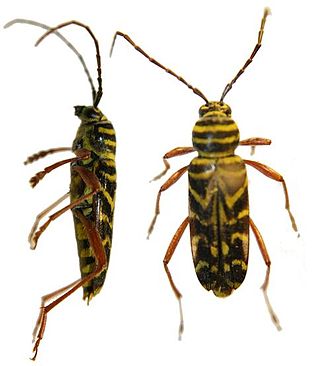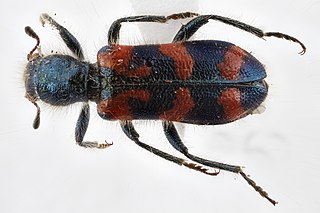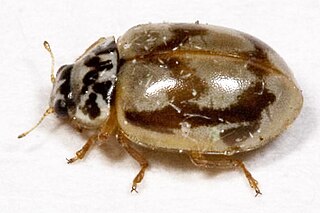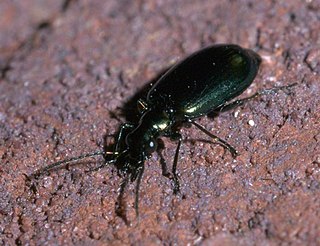
Beetles are insects that form the order Coleoptera, in the superorder Holometabola. Their front pair of wings are hardened into wing-cases, elytra, distinguishing them from most other insects. The Coleoptera, with about 400,000 described species, is the largest of all orders, constituting almost 40% of described insects and 25% of all known animal species; new species are discovered frequently, with estimates suggesting that there are between 0.9 and 2.1 million total species. Found in almost every habitat except the sea and the polar regions, they interact with their ecosystems in several ways: beetles often feed on plants and fungi, break down animal and plant debris, and eat other invertebrates. Some species are serious agricultural pests, such as the Colorado potato beetle, while others such as Coccinellidae eat aphids, scale insects, thrips, and other plant-sucking insects that damage crops.

Dynastes tityus, the eastern Hercules beetle, is a species of rhinoceros beetle native to the Eastern United States. The adult's elytra are green, gray or tan, with black markings, and the whole animal, including the male's horns, may reach 60 mm (2.4 in) in length. The larvae feed on decaying wood from various trees.

Phanaeus vindex, the rainbow scarab, is a North American species of true dung beetle in the family Scarabaeidae. It is found in eastern and central United States and in adjacent far northern Mexico. It is the most widespread species of Phanaeus in the United States and it has a wide habitat tolerance. It may hybridize with the generally less common P. difformis.
The most recent understanding of the evolution of insects is based on studies of the following branches of science: molecular biology, insect morphology, paleontology, insect taxonomy, evolution, embryology, bioinformatics and scientific computing. It is estimated that the class of insects originated on Earth about 480 million years ago, in the Ordovician, at about the same time terrestrial plants appeared. Insects are thought to have evolved from a group of crustaceans. The first insects were landbound, but about 400 million years ago in the Devonian period one lineage of insects evolved flight, the first animals to do so. The oldest insect fossil has been proposed to be Rhyniognatha hirsti, estimated to be 400 million years old, but the insect identity of the fossil has been contested. Global climate conditions changed several times during the history of Earth, and along with it the diversity of insects. The Pterygotes underwent a major radiation in the Carboniferous while the Endopterygota underwent another major radiation in the Permian.

Opheodrys aestivus, commonly known as the rough green snake, is a nonvenomous North American colubrid. It is sometimes called grass snake or green grass snake, but these names are more commonly applied to the smooth green snake. The European colubrid called grass snake is unrelated. The rough green snake is docile, often allowing close approach by humans, and seldom bites. Even when bites occur, they have no venom and are harmless.

The Halloween pennant is a species of dragonfly in the family Libellulidae. It is native to eastern North America, as well as the West Indies.

The mandible of an arthropod is a pair of mouthparts used either for biting or cutting and holding food. Mandibles are often simply called jaws. Mandibles are present in the extant subphyla Myriapoda, Crustacea and Hexapoda. These groups make up the clade Mandibulata, which is currently believed to be the sister group to the rest of arthropods, the clade Arachnomorpha.

Calosoma is a genus of large ground beetles that occur primarily throughout the Northern Hemisphere, and are referred to as caterpillar hunters or caterpillar searchers. Many of the 167 species are largely or entirely black, but some have bright metallic coloration. They produce a foul-smelling spray from glands near the tip of the abdomen. They are recognizable due to their large thorax, which is almost the size of their abdomen and much wider than their head.

Coccinellidae is a widespread family of small beetles. They are commonly known as ladybugs in North America and ladybirds in the United Kingdom; "lady" refers to mother Mary. Entomologists use the names ladybird beetles or lady beetles to avoid confusion with true bugs. The more than 6,000 described species have a global distribution and are found in a variety of habitats. They are oval beetles with a domed back and flat underside. Many of the species have conspicuous aposematic (warning) colours and patterns, such as red with black spots, that warn potential predators that they taste bad.

Megacyllene robiniae, commonly known as the locust borer, is a species of longhorn beetle endemic to eastern North America. It is a serious pest of Robinia pseudoacacia, the black locust tree, with which it is sympatric.

Mezium americanum, the American spider beetle or black spider beetle, is a species of beetle in the subfamily Ptininae, the spider beetles. These are sometimes mistaken for spiders or mites because of their rounded abdomens and long legs. It has a cosmopolitan distribution, but it is an exotic species in Australia.

Jerusalem crickets are a group of large, flightless insects in the genera Ammopelmatus and Stenopelmatus, together comprising the tribe Stenopelmatini. The former genus is native to the western United States and parts of Mexico, while the latter genus is from Central America.

Insects are hexapod invertebrates of the class Insecta. They are the largest group within the arthropod phylum. Insects have a chitinous exoskeleton, a three-part body, three pairs of jointed legs, compound eyes, and a pair of antennae. Insects are the most diverse group of animals, with more than a million described species; they represent more than half of all animal species.

Carabus granulatus is a species of beetle. It is found across the Palearctic from Ireland to the Russian Far East and has been introduced to North America. It is widespread in Europe. C. granulatus lives in fields, prairies, taiga and in forests. Also along river margins, in fens, lakeshores, and upland peat. It is occasional in gardens.

Coleomegilla maculata, commonly known as the spotted lady beetle, pink spotted lady beetle or twelve-spotted lady beetle, is a large coccinellid beetle native to North America. The adults and larvae feed primarily on aphids and the species has been used as a biological control agent. Based on name connotation and to avoid confusion with other species also called "spotted ladybeetle", spotted pink ladybeetle is probably the most appropriate common name for this species.

Trichodes ornatus, commonly known as ornate checkered beetle, is a beetle species of checkered beetles belonging to the family Cleridae, subfamily Clerinae which can be found only in North America.

Mulsantina picta is a species of ladybug belonging to the subfamily Coccinellinae.

Olla v-nigrum is a species in the family Coccinellidae, in the suborder Polyphaga. The species is known generally as the ashy gray lady beetle. The distribution range of Olla v-nigrum includes Central America, North America, and Oceania. It is usually gray or pale tan with small black spots on its elytra and thorax. However, a variation can resemble Chilocorus orbus. This form is black with two red spots on the wing covers and has white on the edge of the prothorax.

Lebia viridis is a species of predatory ground beetle in the family Carabidae. It is found in North America, Guatemala, Mexico and on Cuba. It measure 5 to 7 mm. Diurnal; can sometimes be very common on flowers and vegetation.

Melanophila acuminata, known generally as the black fire beetle or fire bug, is a species of metallic wood-boring beetle in the family Buprestidae. It is found in the Caribbean, Europe and Northern Asia, Central America, North America, and Southern Asia. They get their common name due to the fact that they swarm freshly burned conifer trees, which they find using sensors on their thorax. Adults are black and 7-11 mm in length.



















